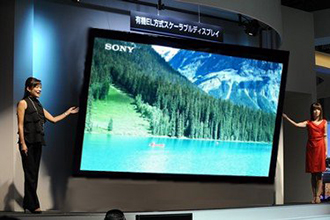Is Sony Reconsidering OLED?
 Rumors have been flying today because of a story written by the Nikkei Asian Review claiming that Sony is getting out of OLED TVs to focus on 4K LCD TVs. On the other hand, we have seen reports that quote Sony as denying this development. What exactly is going on is unclear, but it is not unreasonable to assume that Sony is taking a measured look at OLED TVs with the outcome perhaps to be revealed soon.
Rumors have been flying today because of a story written by the Nikkei Asian Review claiming that Sony is getting out of OLED TVs to focus on 4K LCD TVs. On the other hand, we have seen reports that quote Sony as denying this development. What exactly is going on is unclear, but it is not unreasonable to assume that Sony is taking a measured look at OLED TVs with the outcome perhaps to be revealed soon.
According to the Nikkei report, Sony will reassign the people now working to develop OLED TVs at the Atsugi Technology Center and elsewhere to other tasks, including development of 4K-related products. At the same time, the company will take steps to cut costs in order to turn its TV business around. That includes plans to slash labor expenses for consumer electronics products by more than 20 percent.
Countering this report is news from the UK’s What-HiFi magazine that claims Sony sent them a statement denying the Nikkei report. Sony’s statement reads: “Sony has made no announcement in this regard. Sony continues developing and looking into reliable ways to mass produce OLED displays for consumers while continuing to build experience via providing OLED displays for professional, medical and broadcast use.”
If Sony is getting out of OLEDs, this will be the second time it has done so. Remember the Sony Xel 1 11.5″ OLED TV the company launched back in 2009 for $2,500? That didn’t last too long.
At CES 2013, it then showed a 56″ OLED TV prototype that it said was being developed with Panasonic and AUO. In December of 2013, Sony ended the partnership with Panasonic stating it would pursue development on its own.
There have also been rumors of Samsung reconsidering OLED TVs as its RGB OLED approach may be having troubling scaling to TV sizes with good yields. LG seems to be going full bore on OLEDs, however with their white OLED/color filter approach.
If Samsung is having yield issues, Sony, which also has an RGB approach, may be experiencing the same. And to be competitive, these OLED sets will have to offer 4K resolution — which will clearly have a yield impact as well.
Most forecasts for OLED TVs are quite modest over the near and midterm and will not make much of a dent in the LCD TV market. That may be OK if you can charge a good premium for the sets or you have other reasons to produce these models. Those reasons might be technology leadership, overlap with other OLED display segments, or brand leadership. Sony certainly wants to be a technology and brand leader in TVs, but has lost so much money over the last decade pursing that goal, that the idea of continuing this quest may be getting some serious push back.
Sony’s most recent financial statement revealed it lost $1.26B in its last fiscal year ended March 31, 2014, which included $248M in losses at its Home Entertainment and Sound Division (which includes TVs). Sales of TVs increased nearly 30 percent to $7.3B due to a larger share of higher-priced models, but the group still saw a loss of $250M. That’s better than last’s year’s loss of $683M, but will it ever get into the black?
Sony also makes a line of professional OLED monitors as well, so will these continue? In my discussions with Sony’s Professional group, it is clear that that part of the business is doing very well. At NAB, they announced new 2K OLED monitors and showed a 4K prototype, which should hit the market soon. These offer reference grade image quality.
But is it sustainable? Many say the market for such expensive displays is more limited than it used to be and alternatives are emerging. For example, quantum dot technology in LCD is going to give OLEDs a run for their money in terms of color gamut. The Rec 2020 color gamut is coming so what technologies can meet that need? Sony already uses quantum dots in their LCD TVs, so may be considering using quantum dots in the future and eliminating OLEDs — but that is mere speculation.
OLEDs offer the best black levels too, but with dynamic backlights and high dynamic range displays on the horizon, LCDs will start to rival OLEDs as well. In fact, OLED may be at a disadvantage for HDR displays because they may not be able to sustain the peak brightness levels without ramifications.
One area OLEDs clearly excel at is response speed. There are some LCD modes that hope to improve in this area, but none seem on the commercialization horizon right now. Maybe we will learn more about that at next month’s SID’s Display Week in San Diego.





